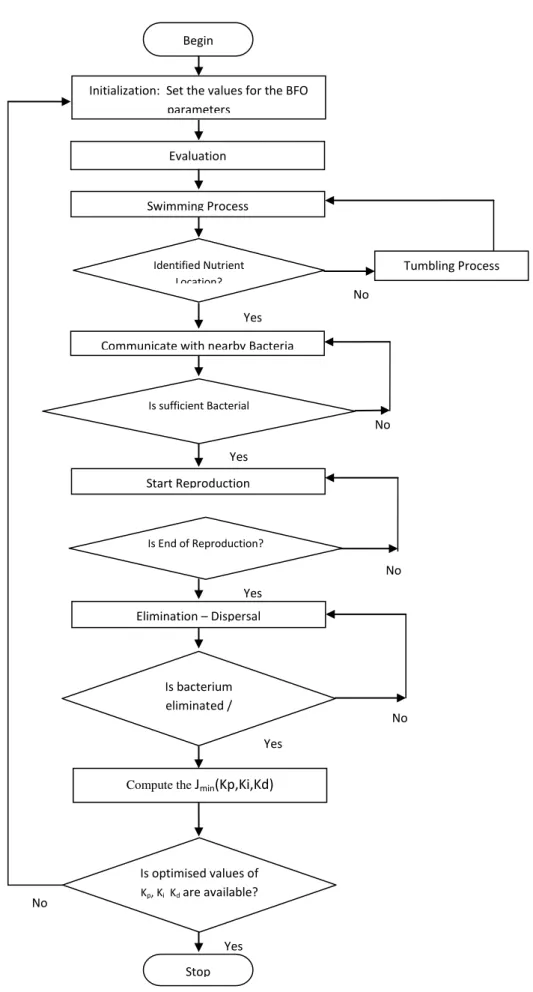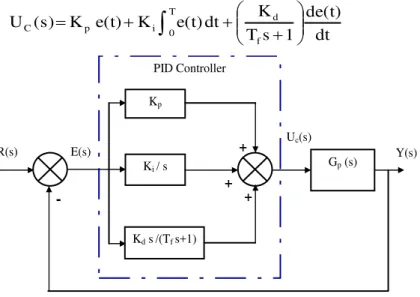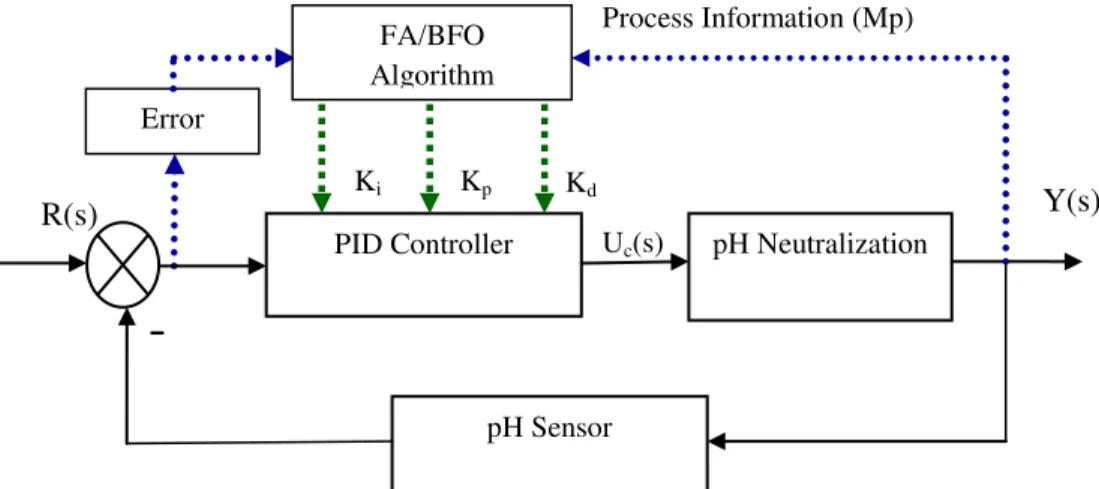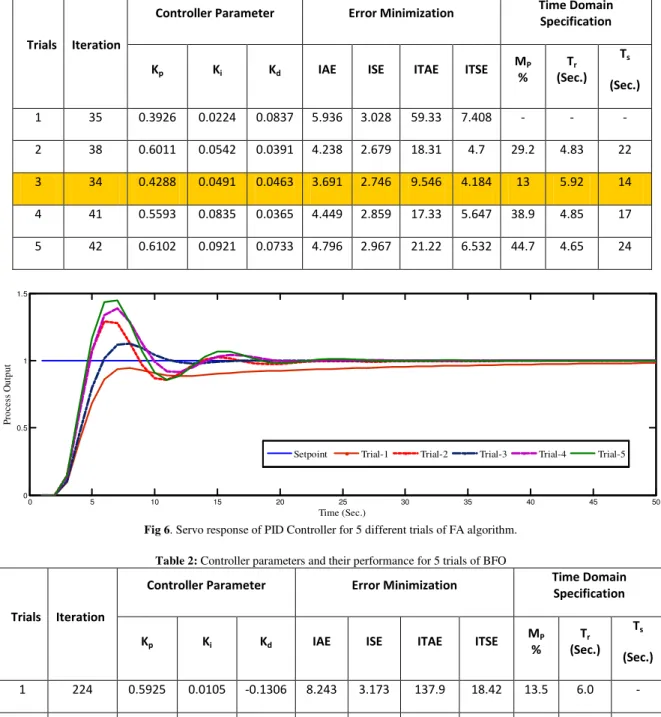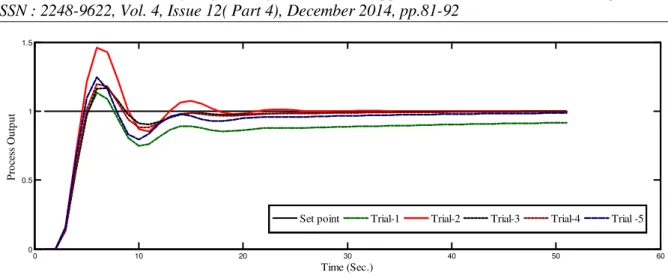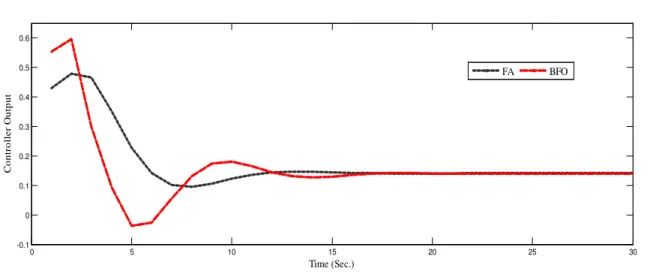A Heuristic Approach for optimization of Non Linear process
using Firefly Algorithm and Bacterial Foraging Algorithm
M. Kandasamy*, Dr. S. Vijayachitra**
*(Department of Electronics and Instrumentation Engineering, Erode Sengunthar Engineering College, Erode -638057, India)
**(Department of Electronics and Instrumentation Engineering, Kongu Engineering College, Erode -638052, India)
Abstract :
A comparison study of Firefly Algorithm (FA) and Bacterial Foraging Algorithm (BFO) optimization is carried out by applying them to a Non Linear pH neutralization process. In process control engineering, the Proportional, Derivative, Integral controller tuning parameters are deciding the performance of the controller to ensure the good performance of the plant. The FA and BFO algorithms are applied to obtain the optimum values of controller parameters. The performance indicators such as servo response and regulatory response tests are carried out to evaluate the efficiency of the heuristic algorithm based controllers. The error minimization criterion such as Integral Absolute Error (IAE), Integral Square Error (ISE), Integral Time Square Error (ITSE), Integral Time Absolute Error (ITAE) and Time domain specifications – rise time, Peak Overshoot and settling time are considered for the study of the performance of the controllers. The study indicates that, FA tuned PID controller provides marginally better set point tracking, load disturbance rejection, time domain specifications and error minimization for the Non Linear pH neutralization process compared to BFO tuned PID controller.
Keywords: Firefly Algorithm (FA), Bacterial Foraging Algorithm (BFO), Optimization Technique, Non- Linear Systems.
I.
INTRODUCTION
Most of the real-world optimization problems are highly nonlinear and multimodal, under various complex constraints. It is more complex and tedious to find out an optimized solution for different objectives. Sometimes, even for a single objective, optimal solutions may not exist at all. In general, finding an optimal solution or even sub-optimal solutions is not an easy task. To solve the
optimization problem, efficient search or
optimization algorithms are needed. There are many optimization algorithms which can be classified in many ways, depending on the focus and characteristics [1].
The heuristic algorithm is such kind of optimization technique which is widely used to obtain best possible optimum solutions for the
problems. By definition “A metaheuristic is a set of
algorithmic concepts (emphasis added) that can be
used to define heuristic methods applicable to a wide
set of different problems. In other words, a metaheuristic is a general-purpose algorithmic framework that can be applied to different
optimization problems with relatively few
modifications” [β]. The metaheuristic algorithm is an
important part of contemporary global optimization algorithms, computational intelligence and soft computing. These algorithms are usually
nature-inspired with multiple interacting agents. A subset of metaheuristics are often referred as Swarm Intelligence (SI) based algorithms and these SI-based algorithms have been developed by mimicking behaviour of birds, fish, humans and others [3]. In recent years, researchers proposed a considerable number of heuristic algorithms such as Genetic Algorithm [4], Bacterial Foraging Optimization [5] Particle Swam Optimization [6], Artificial bee colony optimization [7], Cuckoo search [8], Bat algorithm [9], Firefly algorithm [10] to obtain optimal solutions for more complex engineering
optimization problems. The searching time,
Dimensions of search space, convergence rate, accuracy and effectiveness are important parameters to select a suitable optimization algorithm.
The Firefly Algorithm (FA) is a heuristic algorithm, inspired by the flashing behaviour of fireflies. The
firefly are produces short and rhythmic
bioluminescence flashing light to act as a signal to attract other fireflies to identify its mate as well as share the information of its pray [10].
More research works have been attempted on firefly algorithm to find out solution for optimization problems. Gandomi et al. (2011) performed a study on Firefly Algorithm (FA) to solve mixed
continuous/ discrete structural optimization
problems [11]. Senthilnath et al. (2011) performed
research work on clustering on benchmark problems using Firefly Algorithm and compared the performance of the Firefly Algorithm with the Artificial Bee Colony (ABC), Particle Swarm Optimization (PSO) [12]. A research work is carried out by Raja et al. (2013) regarding an unstable first order and second order model of the process and implemented PID controller with help of firefly algorithm based optimization [13]. The study has shown the better performance of the firefly algorithm compared with the other optimization techniques. Recently, the FA is adapted to estimate and control a class of chemical process models [14].
Passino (2002) has proposed the Bacterial Foraging Algorithm based adaptive controller for a liquid level control problem. The perception of foraging activities of Escherichia coli (E. coli) bacteria is used for the optimization technique to find out the best fitted PID controller parameters by
a set of artificial bacteria in the “D” dimensional
search space. Many attempts by researchers have been carried out to find the optimal controller parameters using Bacterial Foraging Algorithm for different categories of engineering optimization problems . Datta et al. (2008) have proposed an improved adaptive approach involving Bacterial Foraging Algorithm to optimize both the amplitude and phase of the weights of a linear array of antennas for maximum array factor at any desired
direction and nulls in specific directions[15]. In their
work, it was found that Bacteria Foraging Algorithm is capable of improving the speed of convergence as well as the precision in the desired result. Bhushan et al. (2011) have been implemented the bacterial foraging algorithm for identification and high performance speed control system for a DC motor [16]. Recently, Rajinikanth and Latha (2012) discussed about the BFO-tuned I-PD controller performance on a class of time delayed unstable process models [17].
In the proposed work, Nonlinear pH
neutralization process is chosen as an application for which Firefly algorithm and Bacterial Foraging Algorithm optimization technique have used to find out the best optimized PID controller parameters such as Kp,Ki Kd. The predicted controller
parameters are tested in simulated environment to control the pH neutralization process and their results have been compared. The simulation results exhibited that FA based controller has an improved performance indices against BFO based controller. The remaining part of the paper is organized as follows: Section 2 provides Firefly Algorithm and section 3 presents the concept of BFO algorithm. The section 4 brief about the pH Neutralization Process, PID Controller Structure and Controller Tuning By Heuristic Algorithms. The section 5 deals
about results and discussions and followed by the conclusion of the research work in Section 6.
FIREFLY ALGORITHM (FA)
A chemically produced light is generated by fireflies at their lower Abdomen. The induced light pattern is used to establish communication with
neighbour firefly to share the information about its
food and also for mate. The firefly algorithm use the following three idealized rules [10, 18 and 22]
• All the fireflies are unisex so that one firefly is
attracted by other fireflies regardless of their
sex.
• The attractive signals of fireflies are proportional to its brightness of the light. Both attractiveness and brightness are reducing when the distance between the fireflies are increasing. Also, less bright firefly move towards another firefly which induces more luminance. In case, all fireflies have lesser luminance, they move randomly till identify the brighter firefly.
• The brightness of a firefly is related with the analytical form of the objective function and it is assigned to guide the search process.
For a maximization problem, brightness of a firefly is considered as to be proportional to the value of cost function.
Fundamentals of the FA
The most important parameters which decide the efficiency of the FA are the variation of light intensity and attractiveness between neighbouring fireflies. Both the parameters are affected when the fireflies maintain more distance between each of them.
The equation (1) expresses the variation of brightness in the Gaussian form,
2 0
)
(
r
I
e
rI
(1)Where I = New light intensity, I0 = Original
light intensity, = light absorption coefficient and r = Distance between fireflies.
Firefly‟s attractiveness is proportional to the
light intensity of the nearby firefly. The
attractiveness of firefly can be given by
2 0
r
e
(2)
Where, = attractiveness coefficient, and 0 =
attractiveness at r = 0.
2 0 1
r
(3)
The equations (2) describe a characteristic
distance Г = 1/ over which the attractiveness
significantly changes from 0 to 0e
-1
. The
attractiveness function (r) can be any
monotonically decreasing functions and it is given by
m
r
e
d
0 )
( Where
m
1
(4)For a fixed , the characteristic length becomes
Г= -1/m→ 1, m → ∞
Conversely, for a particular length scale Г, in an optimization problem, the parameter can be used
as a typical initial value. This value is
= 1/Г m (5) The Cartesian distance between two fireflies i
and j at xiand xj, in the n dimensional search space
can be mathematically expresses as
The movement of firefly i is attracted by another brighter firefly j is given by
)
(
2 0
,
i j r i
new
i
x
e
x
x
x
ij(7)
Where,
x
inew is updated (present) position offirefly,
x
iis initial position of firefly and)
(
2 0
,
i j r
x
x
e
ij
is attraction betweenfireflies.
Also the parameter
=
i. Where,
iis vector of random number which is drawn from aGaussian distribution and α is the randomization
parameter.
The equation 7 implies that the updated position of the ith firefly depends on initial position of the firefly, attractiveness of firefly towards the brightness and the randomization parameter.
In this study, the the firefly algorithm is assigned with the following values to obtain controller
parameters. Number of fireflies (n) = 1β, 0= 1, = 6 α0 = 0.5 (gradually reduced to 0.1 in steps of 0.001
as iterations proceed) and the total number of run is chosen as 1,000.
BACTERIAL FORAGING OPTIMIZATION ALGORITHM
Bacterial Foraging Optimization (BFO) algorithm is a new division of biologically inspired computing technique introduced by Passino in 2000 . It is based on mimicking the foraging methods for positioning,
handling and ingesting food behaviour of
Escherichia coli (E. coli) bacteria living in human intestine [5,21]. The algorithm has an advantage of high computational efficiency, simple design procedure, and stable convergence. The flow chart shown in Fig. 1 gives the flow of BFO algorithm and its basic operations with key process.
Chemo-taxis: This process simulates the movement of an E.coli cell towards the food source with swimming and tumbling action via flagella. The bacteria can move in a particular path by swimming and can modify the direction of search during tumbling action. These two modes of operations are endlessly executed by a bacteria its whole lifetime to reach the sufficient amount of positive nutrient gradient.
2
1
, ,
,
(
)
nk
k j k i j
i j
i
x
x
x
x
Fig. 1: Flow chart for bacterial foraging algorithm
Elimination – Dispersal Communicate with nearby Bacteria
Yes
No
Yes
Yes
No
Stop
No
No
No Is bacterium
eliminated / migrated? Start Reproduction
Is End of Reproduction?
Compute the Jmin(Kp,Ki,Kd)
Is optimised values of
Kp, Ki Kdare available?
Begin
Initialization: Set the values for the BFO parameters
Evaluation
Swimming Process
Identified Nutrient Location?
Is sufficient Bacterial
Tumbling Process
Yes
Swarming: This process is carried out by the bacteria to acknowledge the information about optimum path of the food source with other bacteria.
An attraction signal is produced for this
communication between the cells in the E-coli bacteria. Another repellent signal is also produced for noxious reserve. This process helps them to increase the bacterial density at the identified food position in the chemotaxis. The attraction signal is represented by the below equation (8).
)) , , , ( ( i j k l Jcc
Y X l k j J s i i
cc
1 )) , , ( , (
Where
s i n m i m m att att w d X 1 1 2 ) (exp
and
(8)
Where “s” = Total number of bacterium, “n”=
Total parameters to be optimized, datt = Depth of attractant signal released by a bacteria, “Watt” = Width of attractant signal, “hrep” = height of
repellent signals between bacterium, “Wrep” =
weight of repellent signals between bacterium and Jcc(θ,(i,j,k,l)) is the objective function value. “θ” is
the point in the n dimensional search domain till the
jth chemotactic, kth reproduction and lth elimination. Also “θm” is the mth parameter of global optimum
bacteria
Reproduction: In swarming process, the bacteria are gathered as groups in the positive nutrient gradient and which may increase the bacterial density. Later, they are arranged in descending order based on its health values. The least healthy bacteria
eventually expire while healthier bacteria asexually split into two bacteria and maintain the predefined population.
Elimination-Dispersal: This is the closing phase in the bacterial search. The bacterium population may decrease either gradually or suddenly depend on the
environmental criteria such as change in
temperature, and availability of food etc. Significant local rise of temperature may kill a group of bacteria that are currently in a region with a high concentration of nutrient gradients. Actions may take place in such a way that all the bacteria in a location are killed and eliminated (local optima) or a group is relocated (dispersed) into a new food source. The dispersal possibly compresses the chemo-taxis advancement. After dispersal, some bacteria may be located near the superior nutrient
and this process is called “Migration”. The above
events are continued until the entire dimensional search converges to optimal solutions or total number of iterations is reached
In this study the following parameters are assigned to BFO as the preliminary process for optimization search. Number of E. coli bacteria as is ten; number of reproduction steps is assigned as four; length of a swim considered as four ; number of chemo tactic steps is selected as five; number of elimination-dispersal events are considered as two; number of bacterial reproduction is set as five, probability for bacteria eliminated /dispersed is
considered as „0.β5‟; datt is assigned as zero ; Watt is set as „0.5‟ hrepis considered as „0.6‟ and Wrep is assigned as „0.6‟.
APPLICATION EXAMPLE OF NON LINEAR PROCESS OPTIMIZATION
USING FA AND BFO: pH NEUTRALIZATION PROCESS
The mathematical model of closed loop
performance of the pH neutralization [19] is considered in this study to evaluate the performance of FA and BFO algorithms.
Fig. 2: pH neutralization system
s i n m i m m rep rep w h Y 1 1 2 ) (Fig. 2 shows the basic concept of controlling pH neutralization process. In this, pH is controlled by maintaining appropriate flow rate of acid and/or alkaline. The mathematical model of the pH neutralization process is expressed in the form of First Order Plus Time Delay (FOPTD) structure and it is given in the equation (9)
1
54
.
8
0921
.
7
)
(
71 . 1
s
e
s
G
sPID CONTROLLER STRUCTURE
Proportional-Integral-Derivative
(PID) controllers are used in the most of the process industries such as food, chemicals, pharmaceuticals, petroleum, paper industries. The PID controller provides better steady state, transient response as well as it maintain stability, smooth reference
tracking and load disturbance rejection to the process [23,24]. In a closed loop control system, the controller output modify the final control element until the difference between reference input and the process output is zero irrespective of the internal and/or external disturbance signal.
The Fig. 3 shows the basic block diagram of closed loop control systems. In this, Gc(s) is the PID
controller and it act as the controller to control the process of Gp(s). Also the R(s) is reference signal;
Y(s) is controlled output signal; E(s) is error signal; Uc(s) is controller output; The Fig. 4 shows the
structure of parallel PID controller. The
mathematical models of parallel PID controller described in the equations (10) and (11) are widely used and considered for this study.
Fig. 3: Block diagram of Closed Loop Control Systems
1 s T s K s K K (s) G f d i p C
Where, Tf = Td/N; Tf = Filter time constant. Td = Derivative controller time constant (Kd/Kp); N = derivative filter constant. In this study “N” is selected as 10.
The controller output is given as
T 0 f d i p Cdt
de(t)
1
s
T
K
dt
e(t)
K
e(t)
K
(s)
U
Fig. 4: Block diagram of Parallel PID control systems
Gc (s) Gp(s)
Reference Input R(s)
Controlled Output Y(s)
-
E (s) Uc (s)
Disturbance D(s)
(9)
Ki / s
Kd s/(Tf s+1)
Gp (s) Kp
PID Controller
Y(s) R(s) E(s)
Uc(s)
CONTROLLER TUNING BY HEURISTIC ALGORITHM
The controller parameters Kp , Ki, Kd are used to determine the performance of PID controller in most
of the processes. In this study, the optimum controller parameters for the PID controller are obtained from the Heuristic algorithms such as FA and BFO for the pH neutralization process. The Fig. 5 shows the basic structure of FA/BFO algorithm based PID controller tuning controller tuning.
Fig. 5: Block diagram of FA/BFO based controller
Multiple Objective Performance Index (MOPI)
Initially, the boundary values of PID are assigned to guide the optimization algorithm and to attain the good accuracy. Many researchers have proposed the Multiple Objective Performance Index (MOPI) such as overshoot (Mp), settling time (ts), steady state error (ess), rise time (tr), gain margin (GM) and phase margin (PM)
for PID controller optimization [17,20]. The following MOPI equation is considered to obtain the controller Parameter Kp, Ki and Kd for the study of heuristic algorithms performance.
)
.
(
)
.
(
)
.
(
)
.
(
)
.
(
)
,
,
(
1 2 3 4 5min
k
pk
ik
dw
ISE
w
IAE
w
M
pw
t
sw
t
rJ
(12)Where Jmin (Kp,Ki,Kd) - Performance criterion
ISE - Integral Square Error IAE - Integral absolute Error
Mp - Peak Overshoot is the difference between maximum peak value of the response curve c(tp) and final value
of c(t)
ts - Settling time is time required for the response curve to reach and stay within 2% of the final value.
tr - Rise time is time required for the response to rise from 0% to 100% of its final value.
w1, w2, w3, w4 and w5 are weighting functions of the MOPI parameters and the value of “w” varies from 0 to 10.
The following parameters are assigned to MOPI as the preliminary process for optimization search.
• Dimension of the search is assigned as three ( Kp, Ki, Kd); • The limits of the three dimensional search space is as
Kp = 0% < Kp < +50%
Ki = 0% < Ki < +25%
Kd = 0% < kd < +50%
• The weighting function values are assigned as w1 =w2 = w3 = 10, w4 = w5 = 6. • The reference input signal „R(s)‟ is unity.
• The “tr” is chosen as <β5% of the maximum simulation time. The settling time „ts‟ is selected as <50%
of the maximum simulation time.
• The overshoot in the process output „Mp‟ is considered as <10% of the reference signal. • The steady state error (ess) of process output is assigned as zero.
• Maximum simulation time is 100 sec. The simulation time is selected based on the process time delay.
RESULTS AND DISCUSSIONS
Five trials are carried out for each algorithm optimization search. The convergence of the Firefly Algorithm (FA) towards finding the optimum controller parameters are presented in the Table 1. The Fig. 6
pH Sensor
Y(s)
PID Controller pH Neutralization
R(s)
-
Uc(s)
FA/BFO Algorithm Error
Process Information (Mp)
depicts the qualitative comparison of the servo response for the trial values presented in Table 1. It is interpreted that the trial value with iteration 34 is best optimal value compared to other trial values.
Table 1: Controller parameters and their performance for 5 trials of FA
Fig 6. Servo response of PID Controller for 5 different trials of FA algorithm.
Table 2: Controller parameters and their performance for 5 trials of BFO
Trials Iteration
Controller Parameter Error Minimization Time Domain
Specification
Kp Ki Kd IAE ISE ITAE ITSE
MP
% Tr
(Sec.) Ts
(Sec.)
1 224 0.5925 0.0105 -0.1306 8.243 3.173 137.9 18.42 13.5 6.0 -
2 272 0.6478 0.0929 0.5311 4.693 2.919 20.19 6.252 46.0 4.55 20
3 284 0.5523 0.0438 0.5863 4.024 2.595 19.61 4.002 17.0 5.15 22
4 216 0.5826 0.0424 0.6200 4.201 2.591 23.28 4.176 19.7 4.95 24
5 256 0.6515 0.0315 0.6470 5.155 2.652 46.42 5.646 24.8 4.76 43
0 5 10 15 20 25 30 35 40 45 50
0 0.5 1 1.5
Time (Sec.)
P
ro
ce
ss
O
u
tp
u
t
Setpoint Trial-1 Trial-2 Trial-3 Trial-4 Trial-5 Trials Iteration
Controller Parameter Error Minimization Time Domain
Specification
Kp Ki Kd IAE ISE ITAE ITSE
MP
% Tr
(Sec.) Ts
(Sec.)
1 35 0.3926 0.0224 0.0837 5.936 3.028 59.33 7.408 - - -
2 38 0.6011 0.0542 0.0391 4.238 2.679 18.31 4.7 29.2 4.83 22
3 34 0.4288 0.0491 0.0463 3.691 2.746 9.546 4.184 13 5.92 14
4 41 0.5593 0.0835 0.0365 4.449 2.859 17.33 5.647 38.9 4.85 17
Fig 7. Servo response of PID Controller for 5 different trials of BFO algorithm.
Similar Procedure is attempted for the FOPTD model of the neutralization process through BFO algorithms. For each algorithm, five trials are executed and the obtained controller parameters are presented in the Table 2 and it is depicted in the Fig.7. From the observation it is found that the third trial with iteration 284 is best optimal controller tuning parameters compared with the remaining trial values. The best performance trial values are highlighted in the table for easy observation.
The best performance trial values produced by both the algorithm such as FA and BFO are tabulated in the table 3.
Table 3: Comparison of FA and BFO Algorithm based PID Controller performance Indices
Algorithm Iteration
Controller Parameter Error Minimization Time Domain Specification
Kp Ki Kd IAE ISE ITAE ITSE
MP
% Tr
(Sec.) Ts
(Sec.)
FA 34 0.4288 0.0491 0.0463 3.691 2.746 9.546 4.184 13 5.92 14 BFO 284 0.5523 0.0438 0.5863 4.024 2.595 19.61 4.002 17.0 5.15 22
Fig.8: Comparison of Servo Response of FA and BFO algorithm based PID Controllers Tuning
0 10 20 30 40 50 60
0 0.5 1 1.5
Time (Sec.)
P
ro
ce
ss
O
u
tp
u
t
Set point Trial-1 Trial-2 Trial-3 Trial-4 Trial -5
0 5 10 15 20 25 30
0 0.2 0.4 0.6 0.8 1 1.2
Time (Sec.)
R
ef
er
en
ce
T
ra
ck
in
g
Fig. 9: Controller output for servo Response of different PID Controllers Tuning
The performances of the FA and BFO tuned PID controllers are tested on the FOPTD model of the neutralization process using equation (9). The servo control and regulatory control tests are also conducted. The servo response of PID Controller tuning using both the algorithms is shown in Fig.8 and its corresponding controller output is shown in Fig.9. It is observed that the performance of both the algorithms is very good and also their error minimization criterion and Time Domain Specification results are very closer. However in deep analysis it is found that the performance of FA has better set point tracking than BFO. Also, number of iteration indicates that the Firefly algorithm has excellent convergence speed ahead of BFO.
Fig. 10: Regulatory Response for different PID Controllers Tuning
Fig. 11: Controller output for Regulatory Response of different PID Controllers Tuning
0 5 10 15 20 25 30
-0.1 0 0.1 0.2 0.3 0.4 0.5 0.6
Time (Sec.)
C
o
n
tr
o
ll
e
r
O
u
tp
u
t
FA BFO
0 10 20 30 40 50 60 70 80 90
0 0.2 0.4 0.6 0.8 1 1.2 1.4 1.6 1.8 2
Time (Sec.)
P
ro
ce
ss
R
es
p
o
n
se
Setpoint FA BFO
0 10 20 30 40 50 60 70 80 90
-0.4 -0.2 0 0.2 0.4 0.6
Time (Sec.)
C
o
n
tr
o
ll
e
r
O
u
tp
u
t
In continuation of the servo response analysis, regulatory response analysis is also executed to study the fitness of the controller to evaluate the performance of FA and BFO algorithms. In this test, a load disturbance is given after 50 seconds to study the load disturbance capability of the controller. The Fig.10 and Fig.11 show that are shows the Regulatory Response and corresponding controller output. It indicates that the firefly algorithm based controller has quickly settled out after the disturbance compared with BFO algorithm based controller. In this study the both the servo response and regulatory response indicates that Firefly algorithm based controller has marginally better performance over the BFO algorithm based controller.
CONCLUSION
The performance of Firefly Algorithm (FA) and
Bacterial Foraging Algorithm (BFO) is
demonstrated with help of mathematical model of pH neutralization process. The test result shows that the computational speed of convergence of FA is faster than convergence of BFO. In the each algorithm 5 trials are carried out to obtain the best optimized controller parameters. Among the 5 trial values, the best convergence value from each algorithm is selected for the study. The servo response and regulatory response test are conducted to study the performance of both the algorithm based controllers. The comparative study is carried out with help of time domain specifications and error minimization. The study tested that the performance of Firefly algorithm based PID controller which produced marginally better result compared with the Bacterial Foraging Algorithm for the non linear pH neutralization process.
REFERENCES
[1] Xin-She Yang, 2011, Scholarpedia,
6(8):11472, doi:10.4249/scholarpedia.11472 Cambridge University, UK
[2] Dorigo, M., M. Birattari, and T. Stutzle,
β006, “Ant colony optimization,” IEEE
Comp. Intell. Mag., Vol. 1, No. 4, 28–39.
[3] Xin-She Yang and Xingshi He, 2013,
"Firefly Algorithm: Recent Advances And
Applications," Int. J. Swarm Intelligence, Vol. 1, No. 1, Pp. 36-50.
[4] Mitchell, Melanie, 1996 “An Introduction to
Genetic Algorithms. Cambridge”, MA: MIT
Press. ISBN 9780585030944.
[5] Passino, K. M., 2002. Biomimicry of
bacterial foraging for distributed
optimization and control, IEEE Control Systems Magazine, vol. 22, no. 3: 52–67.
[6] Kennedy, J and R.C. Eberhart, 1995
“Particle swarm optimization”, In
Proceedings of IEEE international
conference on neural networks, pp: 1942-1948.
[7] Basturk, B., Karaboga, D., β006, “An Artificial Bee Colony (ABC) algorithm for
numeric function optimization”,IEEE Swarm
Intelligence Symposium, Indianapolis,
Indiana, USA.
[8] Yang, X. S., 2008, “Nature-Inspired
Metaheuristic Algorithms”, Frome:Luniver Press.UK, ISBN 1-905986-106.
[9] Yang, X.S., β011, “Bat algorithm for multi
-objective optimization” International Journal
of Bio-Inspired Computation 3(5), 267–274. [10] Yang, X.-S., β009, “Firefly Algorithms for
Multimodal Optimization”, In: Watanabe,
O.,Zeugmann, T. (eds.) SAGA 2009. LNCS,
vol. 5792, pp. 169–178. Springer,
Heidelberg.
[11] Amir Hossein Gandomi, Xin-She Yang,
Amir Hossein Alavi, β011, “Mixed variable
structural optimization using Firefly
Algorithm”, Computers & Structures,
Volume 89, Issues 23–24, Pages 2325–2336. [12] Senthilnath, J., S.N. Omkar, V. Mani, 2011
“Clustering using firefly algorithm: Performance study”, Swarm and
Evolutionary Computation, Volume 1, Issue 3, Pages 164–171.
[13] Raja N.S.M., Manic, K.S. and
Rajinikanth,V., β01γ “Firefly Algorithm
with Various Randomization Parameters: An
Analysis”, In B.K. Panigrahi et al. (Eds.):
SEMCCO 2013, Part.1, Lecture notes in computer science (LNCS 8297), pp. 110– 121.
[14] Rajinikanth V. , K. Latha, N. Sri Madhava
Raja, β01γ, “Model Parameter Estimation
Procedure for a Class of Dynamic Systems
using Firefly Algorithm”, International
Journal of Computational Intelligence
Research, Vol.9, No.2, pp.101-114.
[15] Datta, T., I. S. Misra, B. B. Mangaraj, and S. Imtiaj, 2008, "Improved adaptive bacteria foraging algorithm in optimization of
antenna array for faster
convergence," Progress In Electromagnetics Research C, Vol. 1, 143-157.
[16] Bhushan, B. and M. Singh, β011, “Adaptive control of DC motor using bacterial foraging
algorithm,” Applied Soft Computing, vol. 11, no. 8, pp. 4913–4920.
[18] Pal, S.K., C.S. Rai, A.P. Singh, 2012,
“Comparative Study of Firefly Algorithm
and Particle Swarm Optimization for Noisy Non-Linear Optimization Problems”, International Journal Intelligent Systems and Applications, pp. 50-57.
[19] Meenakshipriya, B., Saravanan K.,
Krishnamurthy K. and Bhaba, P. K., 2012
“Design and implementation of CDM-PI control strategy in pH neutralization
system”, Asian Journal of Scientific
Research, vol. 5, No. 3: 72-92.
[20] Zamani, M., Sadati, N. and Ghartemani, M.
K. β009. Design of an H∞, PID controller
using particle swarm optimization.
International Journal of Control, Automation and Systems, vol. 7, no. 2, pp. 273–280.
[21] M.Kandasamy, Dr.S.Vijayachitra.,
Performance Testing of Non-Linear pH Neutralization Using Bacterial Foraging Algorithm. Aust. J. Basic & Appl. Sci., 8(10): 62-71, 2014
[22] M.Kandasamy, Dr.S.Vijayachitra., Study on
Heuristic Algorithm Based Controller
Optimization for pH Neutralization Process, International Journal of Applied Engineering Research (IJAER), Volume 9, Number 22 (2014)
[23] Vijayan, V. and Rames C. Panda, 2012. Design of PID controllers in double feedback loops for SISO systems with set-point filters. ISA Transactions, 5: 514-521. [24] Vijayan, V. and Rames C. Panda, 2012a.
